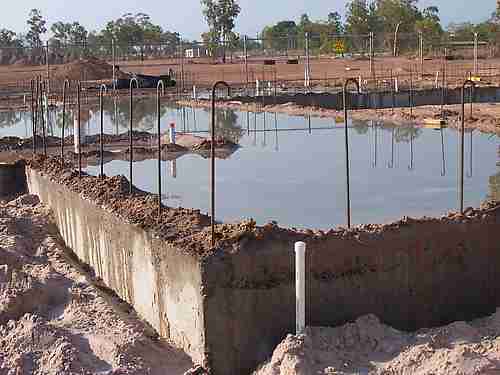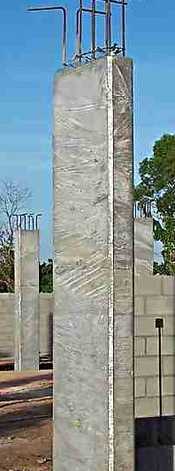Curing Concrete
 |
| Curing a house slab by flooding. The slab is kept wet like this for about 10 days. |
What is concrete curing?
Curing concrete is the term we use for stopping freshly poured concrete from drying out too quickly. The reason that we do this, is because if we let concrete dry out of it's own accord:-
- It will not develop the full bond between all of it's ingredients.
- It will be weaker and tend to crack more.
- The surface won't be as hard as it could be.
Hot or windy weather makes the drying out process quicker. We MUST in some way control the drying process.
Even on a small slab for a garden shed, we are wasting good money and ruining good concrete by not curing it!
"Compressive strength of properly cured concrete is 80 to 100 per cent greater than the strength of concrete which has not been cured at all". Quoted from a CSR Ready Mix Publication.
back to top
There are quite a few methods of curing concrete.
 |
| Curing concrete- The clear plastic sheeting retains the escaping moisture. It is left in position as long as possible, but a minimum of two weeks. The engineering specifications detail curing periods. |
- The formwork itself, if left in place, as in the photo, or on the underneath of a suspended slab, or around a concrete column will stop the concrete drying out too quickly, and so can be said to be a curing agent.
- As in the photo above, by forming a dam wall of sand and then flooding with water. This takes a fair bit of work to do, and then quite often a breach occurs and the water runs off the slab.
Usually this is only done for a few days as it inhibits other work and the pressure is usually on to get the walls up. A possible drawback of this method, especially if soil or clay is used, is the chance of staining the concrete.
- A simpler way is to just keep water sprayed onto the slab with garden sprinklers or hand held hose pipes. Very wasteful of water and again only done for a short period usually. If you hand water, it should be wet all the time, that is you should not let it dry out at all, almost impossible to do.
- Some sort of cover that holds and retains sprayed on water, like a sand layer or hessian. Not a good way to do the job, because they have to be kept wet and if they do dry out they actually aid in sucking moisture out of the concrete.
- A plastic sheet laid on top of the slab stops the evaporation process. This is my favoured method of curing concrete. Usually a spray from a hose pipe is used to wet the surface and the plastic is laid on, with generous laps at the joints. I use timber or cement blocks to keep the plastic in position, rather than taping the joints. To a certain extent the plastic can be used a few times. A major benefit of plastic is that it does not stop other work, like building the walls, and so it can be left in position for weeks if need be.
- The photo shows concrete columns that have had the formwork stripped (for further use) and then wrapped in a clear plastic film. The evaporation from the concrete condenses on the inside of the plastic and the surface of the column remains moist.
- Concrete curing oils or curing compounds now come in a variety of types. I've used the water soluble waxy emulsions that can be sprayed onto the fresh concrete with a hand pump type spray. They are milky white when used but dry into a clear waxy film. They have the advantage that that they can be sprayed onto footpaths and the like even before the concrete is set enough to walk upon. Another major use is on concrete walls. They remain on the surface for weeks and finally break down in sunlight. I would be hesitant to use concrete curing oils on internal floors, on the off chance that any residue would stop the full adhesion of ceramic tile glues etc.
- Other types of concrete curing compounds are PVA based, chlorinated-rubber or resin based. They can also be obtained In coloured versions that fade over time.
back to top
When to start curing concrete?
This is easy! Absolutely as soon as possible. No ifs or buts. Full stop.
The drying process is quickest right after the concrete is poured so the first few hours are critical.
For instance, you and your mates have had a hard afternoon wheelbarrow concrete around the back of your house. When the finishing is done it's getting dark and you settle down to a well earned beer.
Don't leave it at that until tomorrow morning. As soon as it is possible to walk on the concrete without marking it, start curing concrete, get the plastic on (or whatever you are using).
Look at it like this, if someone said to you, "cover the concrete and I'll give you $200". You would jump at it, and yet all the time, people pay good money for a product and yet they sit around drinking and letting it lose value.
back to top
How long to continue curing concrete?
This one is a little bit more flexible.
- If you are working to a set of specifications, or an engineer's instructions, the curing concrete should be done as long as they say.
- Most drawings will not define the time for curing concrete, instead they make a general mention like "All concrete work to be in accordance with (and then call up a series of standards)". Make it your business to find out what those standards say. I don't mean buying the standard, If you don't know ring up someone who does. The building inspector, the engineer, the architect.
- For small non documented jobs, a minimum of three days, but seven days is better.



